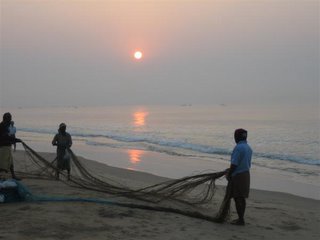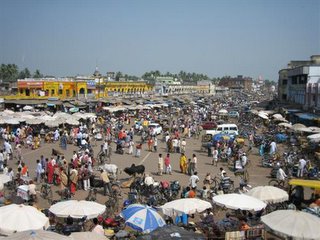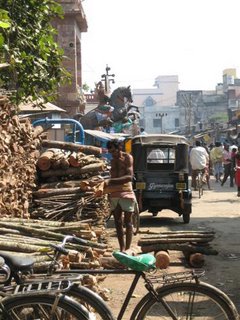Lost wax at Thanjavur

Thanjavur is famous for at least two things: the magnificent World-Heritage "Big Temple" and an unparallelled collection of cast bronzes from up to 1000 years ago. In that collection, there are a number of outstanding pieces, including a number of examples of the well-known subject of "Nataraja" - the dancing Shiva in a ring of fire and some winsome and hyperidealised figures of Parvati, Shiva's wife - as well as many other remarkable examples. Ironically, these bronzes have survived because of the the iconoclasts (sorry, we're there again, but only briefly). When the Mughals were pushing south to extend their empire, the word went ahead of them to hide (i.e. bury) any images that could be moved. So it happened that hundreds, maybe thousands, of these images were buried in the soil of present-day Tamil Nadu - and then forgotten. Maybe the people who hid them were killed or the memory didn't get passed down through the generations in the Mughal period. Now they are being rediscovered: apparently a find was made only last week during a temple renovation. Without the Mughals, perhaps the images would have been stolen, lost, destroyed: here, ironically, iconoclasm has had the effect of preserving the images! It is also quite a thought that underground around this area are still yet more of these masterpieces, waiting for one day to be restored to the light.
They were all made by the lost wax method. This involves making the model in wax and encasing this in fine clay and then another layer of coarser stuff. Next, the clay is heated to harden it - and "lose" the wax, which flows out of an aperture, to be used again. The mould is then buried up to its neck (for support) and molten bronze (brass,copper,tin and a little silver and gold) is poured in. In very little time the mould can be broken open and the image revealed. Quite a lot of finishing detail is finally required to complete the work.
Well, being in Thanjavur I thought I would try to track down the canny guy who those years ago sold me the bronze, made to order as an imitation of one of the Parvati images in the museum. He had a "factory" way out in the country where he took likely customers (me included) to see the lost wax method in action. The first time I called in to see Mr Prakash in his lair (a craft shop in a luxury hotel), he wasn't there so I went off to the Big Temple, and found it as impressive as ever or even more so. A transcript from Mahatma Gandhi praises the custodian of this and 89 other temples (the "Senior Prince") for throwing them open to untouchables (I suppose that includes us lot). In fact, a significant part of the impact of the Big Temple for me relates to just this: the access to the worship or darshan, without any of the nasty Brahmin exclusivity you find at Srirangam (Trichy) and many other places where non-Hindus (and untouchables I suppose) are excluded. The main shrine contains a huge black lingam, sitting as usual within an accommodating yoni; and, as if at an altar rail, the priests anoint devotees with holy ash, pass their hands through a holy flame and hand out grains of some holy food. In one way, it's certainly still a privilege to be let in on the rituals but then, having no practice elsewhere, it is also hard not to feel a bit of a spare part hanging around on the fringes. Still, the priests seemed to be totally accepting of the outside presence.
Apart from the rituals, the temple is pricipally impressive for its scale and artistry and above all for its soaring tower. It's not a gopuram here - more like a very steep pyramid, 66 metres in height, covered in elaborate carvings. Another thing the tower has in common with pyramids is the method used to install the vast capstone on the top: a ramp 4 kilometres long was constructed and the 80-ton stone (shaped underneath to slot into place over the layer below) was edged up and along it, probably with the use of elephants.
Suitably uplifted I headed on back in the evening to Mr Prakash's shop and this time he was at home. He sort-of half remembered me and invited me to have a cup of chai with him. Next, there was a trip out to his "Artists' Village" in the outskirts of Thanjavur - at sunset on the back of his scooter! This is where his workers do demonstrations of the ages-old techniques for visitors and likely customers. (This saves the real artists at his main place from being distracted) Right then and there, bronze was being heated then poured into a mould, which was quite quickly cooled and then cracked open to reveal the basic casting ready for final finishing. ...... And then I get asked out for supper! He was quite affable despite being discouraged to hear I was staying in a budget hotel (visions of repeat business fading). However he particularly enjoyed telling his favourite story from a few years back when a piece he was exporting was called in as an original millenium-old bronze and he was on trial for a serious offence. It took two years to clear his name, during which time he was under something of a cloud, but now he's going from strength to strength. After all, it must be something of a boost to your reputation to have your stuff mistaken by the experts as a genuine antique.




